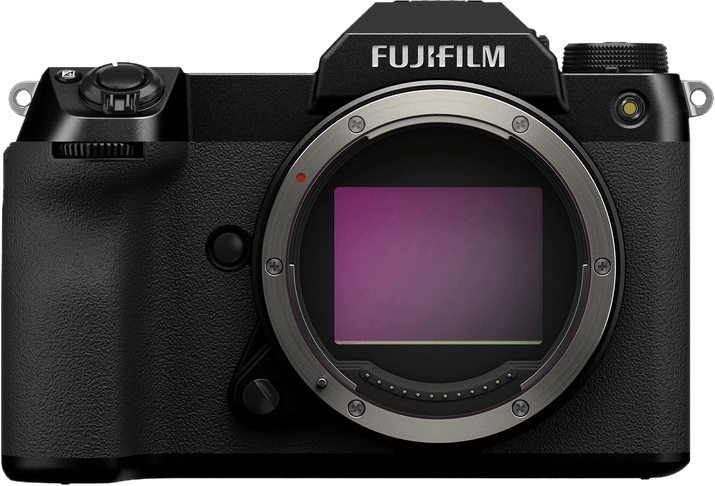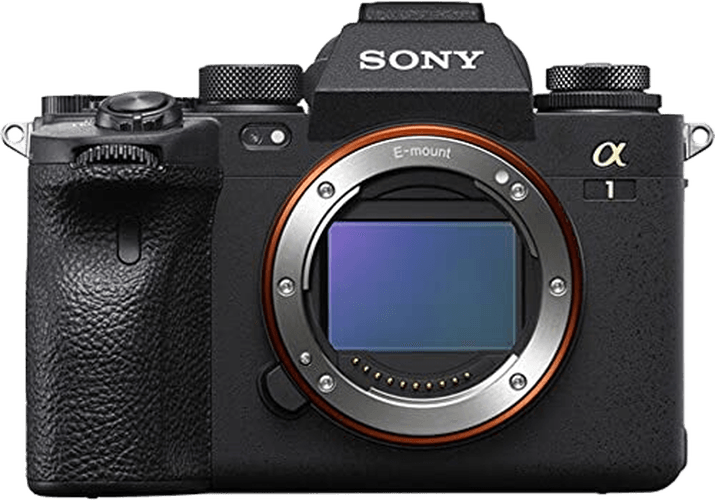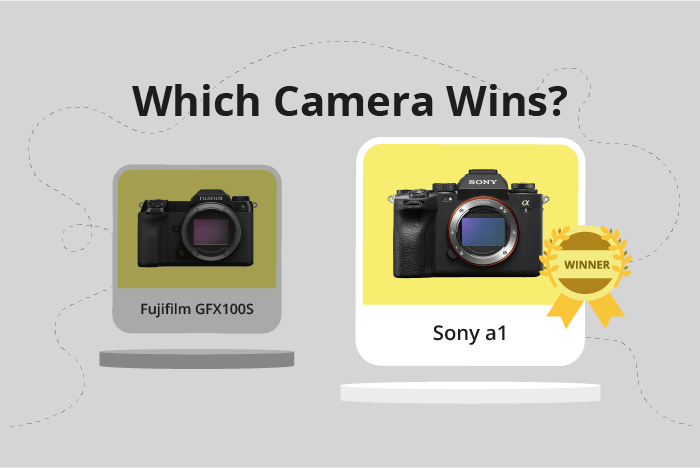Fujifilm GFX100S vs Sony a1 Comparison
Fujifilm GFX100S

Sony a1

The Sony a1 comes out ahead with a score of 86/100, while the Fujifilm GFX100S trails with a score of 80/100. Both cameras share similarities, such as being mirrorless and having a 2021 release year. However, the Sony a1 has a higher launch price of $6,499 compared to the GFX100S at $5,999.
The Sony a1 is better in terms of size and weight, measuring 129 x 97 x 81mm and weighing 737g, making it more portable. On the other hand, the Fujifilm GFX100S is slightly larger and heavier at 150 x 104 x 87mm and 900g.
Despite the Sony a1’s higher price, its superior score signifies better overall performance. However, the Fujifilm GFX100S remains a strong contender, offering excellent features at a lower price point. Both cameras are solid options, with the Sony a1 being the top choice for those prioritizing performance and portability, while the GFX100S is more budget-friendly without sacrificing quality.
Fujifilm GFX100S vs Sony a1 Overview and Optics
The Sony a1 outperforms the Fujifilm GFX100S in optics, scoring 89/100 compared to the GFX100S’s 78/100. Both cameras share some common specifications, such as CMOS sensor type, image stabilisation, and the presence of a high-speed processor. However, there are notable differences that contribute to their varying optical performance.
The Fujifilm GFX100S has a higher megapixel count of 102, compared to the Sony a1’s 50.1. This advantage allows the GFX100S to capture more detail in images, making it ideal for large prints and detailed editing. The GFX100S also features a medium format sensor, which provides better image quality and dynamic range than the Sony a1’s full-frame sensor. Furthermore, the Fujifilm G lens mount offers a unique selection of lenses designed specifically for the medium format system.
On the other hand, the Sony a1 boasts a faster shooting speed of 30 frames per second, which is significantly quicker than the GFX100S’s 5 frames per second. This makes the a1 more suitable for action and sports photography, where capturing fast-moving subjects is crucial. Additionally, the a1 has a DXOMARK sensor score of 98, indicating excellent performance in color depth, dynamic range, and low light capabilities. The Sony FE lens mount also provides a wide range of compatible lenses for various shooting scenarios.
While the Fujifilm GFX100S excels in image resolution and medium format benefits, the Sony a1 offers superior speed and versatility. The choice between these two cameras depends on the photographer’s priorities and specific needs. The GFX100S is better suited for photographers seeking high-resolution images and a unique lens selection, while the a1 is ideal for those who require speed, flexibility, and a wide range of compatible lenses.
Fujifilm GFX100S vs Sony a1 Video Performance
The Sony a1 takes the lead in video capabilities with a score of 86/100, while the Fujifilm GFX100S trails behind with a score of 83/100. Both cameras share some common specifications, such as having 4K video resolution and built-in time-lapse functionality. However, there are noticeable differences that set them apart.
The Sony a1 outperforms the Fujifilm GFX100S in several aspects. Firstly, it boasts a maximum video resolution of 8K, compared to the Fujifilm GFX100S’s 4K resolution. This allows the Sony a1 to capture finer details and produce higher quality videos. Moreover, the Sony a1 has a higher maximum video frame rate of 120fps, twice the frame rate of the Fujifilm GFX100S at 60fps. This feature enables smoother slow-motion footage and better overall video performance.
On the other hand, the Fujifilm GFX100S has an advantage in the time-lapse department, as it comes with built-in time-lapse functionality, which the Sony a1 lacks. This feature makes it easier for users to create stunning time-lapse videos without needing additional equipment or software.
Taking these factors into account, the Sony a1 is the superior option for videographers who prioritize high-resolution video and slow-motion capabilities. The Fujifilm GFX100S, while falling short in these areas, remains a solid choice for those who value the convenience of its built-in time-lapse functionality. Both cameras offer unique benefits, and the ultimate decision will depend on the specific needs and preferences of the user.
Fujifilm GFX100S vs Sony a1 Features and Benefits
The Fujifilm GFX100S wins the features comparison with a score of 87/100, while the Sony a1 scores 83/100. Both cameras share several specifications, including touchscreen capabilities, flip screens, GPS absence, WIFI, and Bluetooth connectivity.
The Fujifilm GFX100S outperforms the Sony a1 in terms of screen size and resolution. With a 3.2-inch screen and a resolution of 2,360,000 dots, the GFX100S provides a clearer and larger display for users to review their images and navigate the camera’s settings. In contrast, the Sony a1 has a smaller 3-inch screen with a lower resolution of 1,440,000 dots.
Despite the Sony a1’s lower feature score, it still offers excellent capabilities. The similarities in touchscreen, flip screen, WIFI, and Bluetooth connectivity make it a competitive choice for photographers who prioritize these features. However, the Fujifilm GFX100S’s superior screen size and resolution give it an edge in the features category.
In comparing the Fujifilm GFX100S and Sony a1, it is evident that the GFX100S is the winner in terms of features, primarily due to its larger screen and higher resolution. The Sony a1 remains a strong contender with its similar specifications, but the GFX100S’s advantages make it a more appealing choice for photographers who prioritize display quality and size.
Fujifilm GFX100S vs Sony a1 Storage and Battery
The Fujifilm GFX100S and the Sony a1 both have a storage and battery score of 73/100. They share similarities in their storage capabilities, with each camera having two memory card slots. Both cameras accept SD, SDHC, and SDXC memory cards, and are UHS-II compatible. Additionally, both cameras have USB charging capabilities.
The Sony a1 has a slight advantage in battery life, providing 530 shots compared to the Fujifilm GFX100S’s 480 shots. This difference may be significant for photographers who need longer shooting sessions without changing batteries. The Sony a1 uses the NP-FZ100 battery type.
On the other hand, the Fujifilm GFX100S accepts the NP-W235 battery type. Although it has a shorter battery life, it still offers a respectable number of shots before needing a battery change.
Both cameras perform well in terms of storage and battery life. The Sony a1 offers a slightly longer battery life, making it more suitable for extended shooting sessions. However, the Fujifilm GFX100S still provides a reliable performance, ensuring that photographers can capture the shots they need.
Fujifilm GFX100S vs Sony a1 – Our Verdict
Are you still undecided about which camera is right for you? Have a look at these popular comparisons that feature the Fujifilm GFX100S or the Sony a1:

